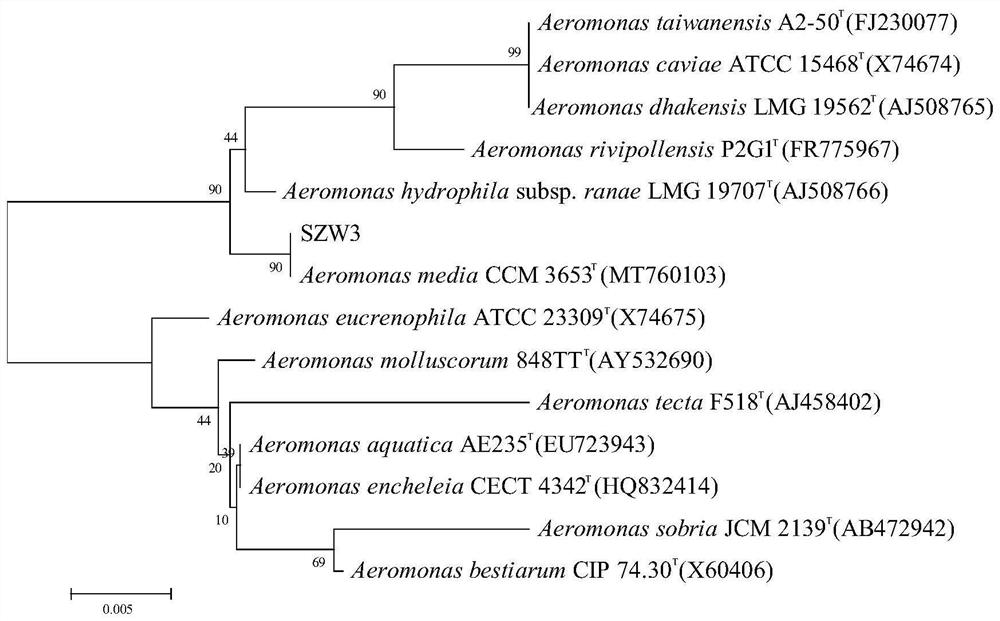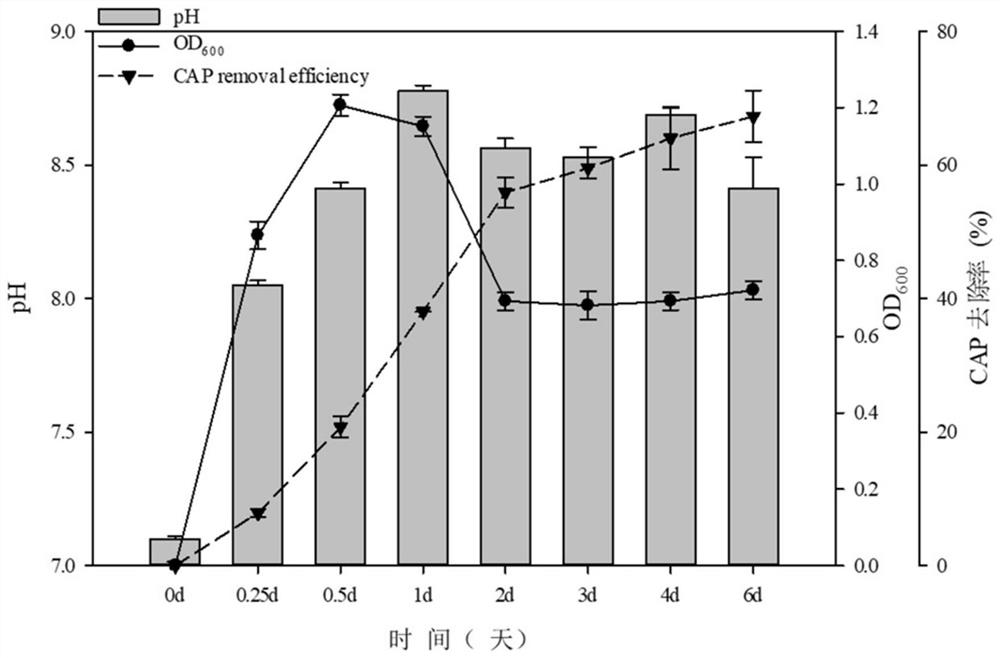A Strain of Aeromonas intermedia and Its Application in Removing Chloramphenicol and Solubilizing Phosphate and Potassium
A technology of Aeromonas and chloramphenicol, applied in the field of microbial remediation of organic pollutants, can solve the problems of difficult hydrolysis and photolysis, damage to bone marrow hematopoietic function, etc., and achieve the effect of increasing soil available phosphorus and potassium content
- Summary
- Abstract
- Description
- Claims
- Application Information
AI Technical Summary
Problems solved by technology
Method used
Image
Examples
Embodiment 1
[0056] Example 1 Screening, isolation, purification and identification of strain SZW3
[0057] 1. Screening method of chloramphenicol degrading strain SZW3
[0058] 1. Material preparation
[0059] Strain screening sample source: An earthworm was excavated from a dry canal next to a pig farm in Longping Town, Lianzhou City, Qingyuan City, Guangdong Province. The earthworm and surrounding soil samples were sealed in a sampling bag, and brought back to the laboratory at 4°C. content.
[0060] LB medium: 10.0 g of peptone, 5.0 g of yeast extract powder, 10.0 g of NaCl, pH 7.0-7.2, dilute to 1 L with distilled water, and add 18.0 g of agar powder to the solid medium. Sterilize at 121°C for 15min.
[0061] Mineral salt medium (MSM): 5 mL of phosphate buffered solution (KH 2 PO 4 8.5g·L -1 , K 2 HPO 4 ·H 2 O21.75g·L -1 , Na 2 HPO 4 ·12H 2 O 33.4g·L -1 , NH 4 Cl 5.0g·L -1 ), 3.0mL 22.5g·L -1 MgSO 4 solution (MgSO 4 ·7H 2 O 46.125g·L -1 ), 1.0mL 0.25g·L -1 FeCl...
Embodiment 2
[0083] Example 2 Bacterial strain SZW3 removes chloramphenicol test
[0084] After streaking the strain SZW3 and culturing it on LB plate at 30°C for 20h, pick a single colony and inoculate it in LB liquid medium, cultivate it in a shaker at 30°C and 150rpm for 20h, and then inoculate it at a ratio of 2% (v / v). Chloramphenicol concentration is 10mg·L -1 contains 10g·L -1 In the inorganic salt liquid medium of peptone, 30℃, 150r·min -1 Shake culture for 0, 0.25, 0.5, 1, 2, 3, 4 and 6 days (d), with no addition of strain SZW3 as blank control (CK), three replicate experiments were set. The removal efficiencies of chloramphenicol were 0, 7.88, 20.76, 38.06, 55.86, 59.56, 64.01 and 64.28%, respectively.
[0085] Strain SZW3 contains 10g·L -1 The degradation kinetics of chloramphenicol in peptone MSM medium is shown in Fig. image 3 As shown, the degradation rate of chloramphenicol as well as strain growth and pH changes as Figure 4 As shown: the growth of SZW3 showed an "S-...
Embodiment 3
[0086] Qualitative test of dissolving phosphorus and potassium of embodiment 3 strain SZW3
[0087] Strain phosphate / potassium solubilizing bacteria (phosphate / potassium solubilizing bacteria, meaning converting insoluble phosphorus and potassium elements into soluble phosphorus and potassium) (specific references: Rawat, P., Das, S., Shankhdhar, D., et al., Phosphate-solubilizing microorganisms: Mechanism and their role in phosphate solubilization and uptake[J]. Journal of Soil Science and Plant Nutrition. 2020, https: / / doi.org / 10.1007 / s42729- 020-00342-7.) Functional test:
[0088] Strain SZW3 was inoculated in LB liquid medium at 125-150r·min -1, 28 ~ 30 ℃ shaking incubator for 18 ~ 24h, then 2% (v / v) was connected to NBRIP or potassium-solubilizing bacterial liquid medium, set up 3 repeated experiments, placed at 30 ℃, 150r·min -1 Incubate in a shaker for 6 days, and measure the content of available phosphorus and potassium in the solution. in,
[0089] NBRIP medium fo...
PUM
| Property | Measurement | Unit |
|---|---|---|
| concentration | aaaaa | aaaaa |
Abstract
Description
Claims
Application Information
 Login to View More
Login to View More - R&D
- Intellectual Property
- Life Sciences
- Materials
- Tech Scout
- Unparalleled Data Quality
- Higher Quality Content
- 60% Fewer Hallucinations
Browse by: Latest US Patents, China's latest patents, Technical Efficacy Thesaurus, Application Domain, Technology Topic, Popular Technical Reports.
© 2025 PatSnap. All rights reserved.Legal|Privacy policy|Modern Slavery Act Transparency Statement|Sitemap|About US| Contact US: help@patsnap.com



